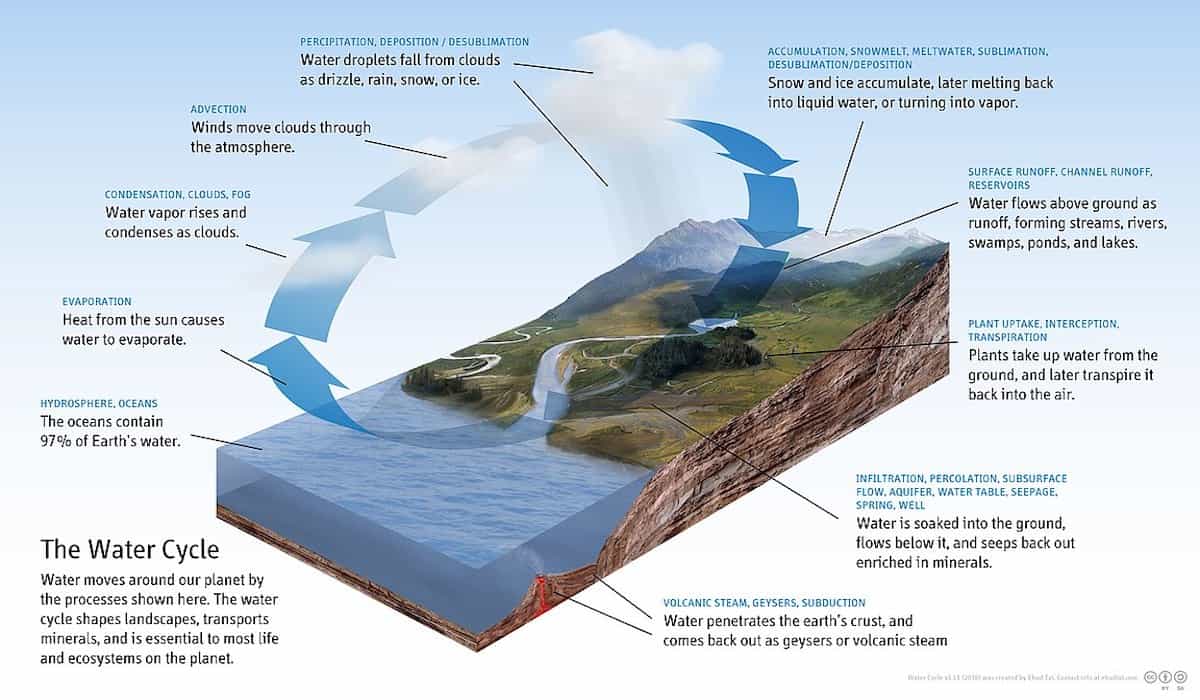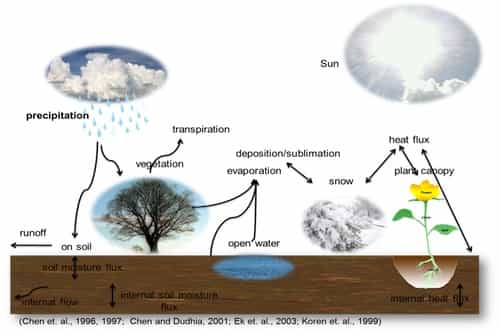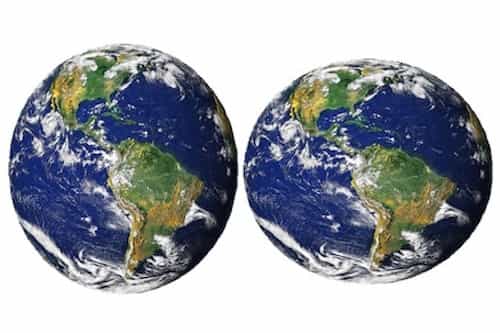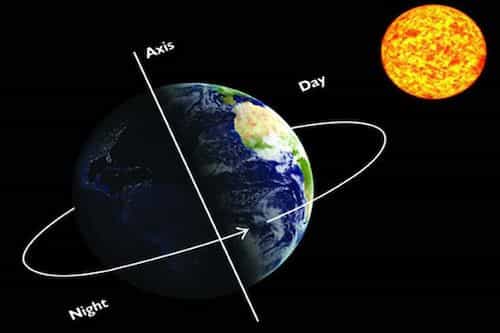Quran Tells About Hydrologic / Water Cycle
What Is Hydrologic Cycle?
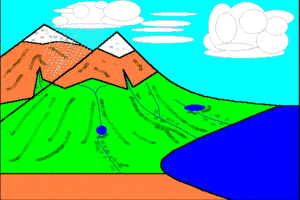
There are thousands of rivers in the world, and all of them individually dumps millions of gallons of water per second into the seas. Where all that water goes as there is no increase in the sea level. The answer lies in the hydrologic cycle, which is the continuous circulation of water in the Earth. This concept was not fully understood until the 15th century AD. The water on the Earth, below and above its surface is in constant motion changing states between liquid, vapor, and ice. Ancient people believed that there is a large underground freshwater lake or several watery hollows that supplied the rivers with water through springs. In earlier times, people did not know the source of underground water. They thought the water of the oceans, under the effect of winds, was thrust towards the depths of the continents. They also believed that the water returned by a secret passage, the Great Abyss. Aristotle somewhat detailed and defined evaporation and condensation but the idea of subterranean water, being the primary source of the supply was prevalent. Today, we know that the rainwater that seeps into the cracks of the ground is responsible for this. And all the water in the rivers is due to a continuous cycle of rain.
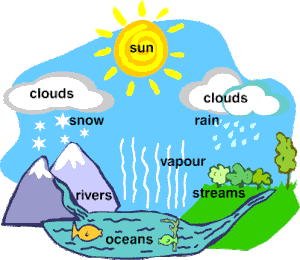
All these theories came about mainly because no one could believe that rainfall was sufficient to keep rivers flowing. In the 17th century AD, Pierre Perrault developed the concept of the hydrological cycle. He and Edme Mariotte were initially responsible for making hydrology an experimental science. With a series of experiments, Perrault showed that rain does not penetrate the soil beyond about 2 feet. Thus, most of the rain that falls does not go into springs. Also, he demonstrated that several times more rain fell than there was water in the river. Also, this cycle of evaporation and rainfall is so much measured and highly precise that now we know that every year all over the world the total rainfall is around 500 trillion tons. This yearly value remains constant.
Hundreds of years ago, the Quran mentioned all these modern concepts of hydrology in detail in various verses and included complete descriptions of the hydrologic cycle.
٢١ أَلَمْ تَرَ أَنَّ اللَّهَ أَنْزَلَ مِنَ السَّمَاءِ مَاءً فَسَلَكَهُ يَنَابِيعَ فِي الْأَرْضِ
Do you not see that Allah sends down rain from the sky and makes it flow as springs…. Surah Zumar 39:21
١٨ وَأَنْزَلْنَا مِنَ السَّمَاءِ مَاءً بِقَدَرٍ فَأَسْكَنَّاهُ فِي الْأَرْضِ ۖ وَإِنَّا عَلَىٰ ذَهَابٍ بِهِ لَقَادِرُونَ
And We send down water from the sky according to (due) measure, and We cause it to soak in the soil; and We certainly are able to drain it off (with ease). Surah Muminun 23:18
PLEASE CLICK THE IMAGE TO OPEN IN LIGHTBOX
Miracle in the use of word “مَاءً”
There is also a miracle in the use of word “مَاءً” as this simply means water in any form. Quran do not use the proper words for Rainfall which in Arabic can be “الْوَدْقَ”, “غَيْثٍ”, “مَطَرٍ” but instead Quran used مَاءً so that later when we calculate the annual precipitation this word would have the capacity that it covers all forms of precipitation (rain, snow, or hail).
Miracle in the use of word “فَسَلَكَهُ”
Further miracle in Surah Zumar Verse 21 is also in the use of “فَسَلَكَهُ” which means “makes it flow” but as you can see in the detailed analysis of this word below it also has sense of “penetration”, “Insertion” in it which as mentioned above… that we now know that the rainwater that seeps/trickle and penetrates into the cracks of the ground is responsible for the subterranean water reserves & springs.
Stores Of Water

These above mentioned verses contain full science and the exact process of hydrology and describe the recirculation of water.
Below in Surah Hijr Quran also tells that it is God who is the guardian of stores of water. Just think that we cannot preserve anything even water more than a certain period of time and it would get spoiled but underground water reserves are kept safe and pure despite being hundreds and thousands of years old.
٢٢ وَأَرْسَلْنَا الرِّيَاحَ لَوَاقِحَ فَأَنْزَلْنَا مِنَ السَّمَاءِ مَاءً فَأَسْقَيْنَاكُمُوهُ وَمَا أَنْتُمْ لَهُ بِخَازِنِينَ
And We send the fecundating winds, then cause the rain to descend from the sky, therewith providing you with water (in abundance), though ye are not the retainers of its stores. Surah Hijr 15:22
DETAILED ANALYSIS OF THE IMPORTANT WORDS USED IS GIVEN BELOW
فَسَلَكَهُ
The ninth word of verse 39:21 is divided into three morphological segments. A conjunction, verb, and object pronoun. The prefixed conjunction “fa” is usually translated as “and”. The perfect verb فعل ماض is the third person masculine singular. The verb’s root is (س ل ك). The attached object pronoun is third person masculine singular. This root occurs 12 times in the Quran as the form I verb salaka (سَلَكَ).
CONJ – prefixed conjunction fa (and) الفاء عاطفة
V – 3rd person masculine singular perfect verb فعل ماض والهاء ضمير متصل في محل نصب مفعول به
PRON – 3rd person masculine singular object pronoun
(سَلَكَ): To make a way, travel, thread a pathway, cause to go along (a way), insert, penetrate, walk, enter. Salakna سلکنا : We have caused to enter. سلک الخیط فی الابرة He inserted the thread into the needle. اسلک یدک فی جیبک Insert thy hand into thy bosom (28:33).
يَنَابِيعَ
The tenth word of verse 39:21 is a masculine plural noun and is in the accusative case منصوب. The noun’s root is (ن ب ع).
N – accusative masculine plural noun اسم منصوب
(ن ب ع): To spring gush forth, flow out issue forth, emerge.
فَأَسْكَنَّاهُ
The sixth word of verse 23:18 is divided into four morphological segments. A resumption particle, verb, subject pronoun, and object pronoun. The connective particle “fa” is usually translated as “then” or “so” and is used to indicate a sequence of events. The form IV perfect verb فعل ماض is first person plural. The verb’s root is (س ك ن). The suffix (نا) is an attached subject pronoun. The attached object pronoun is third person masculine singular. This root occurs 69 times in the Quran, in 10 derived forms.
REM – prefixed resumption particle الفاء استئنافية
V – 1st person plural (form IV) perfect verb فعل ماض و«نا» ضمير متصل في محل رفع فاعل والهاء
PRON – subject pronoun ضمير متصل في محل نصب مفعول به
PRON – 3rd person masculine singular object pronoun
(س ك ن) : To be quiet, rest, repose, dwell, lodge, inhabit, stop, still, subside. Noun “Sakoon” It was or became still, stationary, calm, appeased, allayed; it passed away, or ceased to be; it remitted or subsided. Ease, Comfort. “Uskun”: Dwel. “Maskeen”: poor lovely weak. “Maskan”: Abode dwellingg place/ “Sakeena” Calmness or tranquility; staidness; a quality inspiring reverence; mercy, pity or compassion/ “Sakin” Still, motionless, stationary, calm/ “Sikkînun” A Knife.
لَوَاقِحَ
The third word of verse 15:22 is a masculine plural noun and is in the accusative case منصوب. The noun’s root is (ل ق ح). This root occurs only once in the Quran, as the noun lawāqiḥ (لَوَٰقِح).
N – accusative masculine plural noun اسم منصوب
(ل ق ح): To impregnate, vaccinate, fertilize. Lawâqiha لواقحَ: Impregnating; Fecundating; Fertilizing (by pollination as well as by bringing rain- clouds); Those winds which raise cloud that gives rain; The winds that carry vapours rising from the sea to the upper regions where they assume the form of clouds; Winds that carry pollen from the male to the female plants to fecundate them. These winds are described as pregnant by way of resemblance as they bear drops of water or carry pollens, in opposition to the wind Aqîm which is life-destroying and dry and barren. (51:41).
THE SAME MIRACLE ALSO PRESENT IN BIBLE. PLEASE SEE THE POST BELOW
Water Cycle Mentioned In Bible
Ecclesiastes 1:7 Miracle: Place rivers flow, there they flow again



